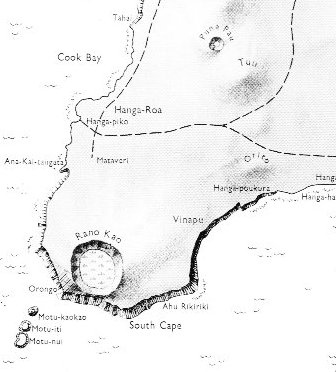|
TRANSLATIONS
I have another question mark. Let us once again read the last phase of the kuhane stations as told by way of the explorers:
On the day Hora iti 20 they went to Papa O Pea, on the day Hora iti 26 they went to Aku Akapu. Between the nights of 'generation' (which I just have proposed as a possible interpretation) on the beaches of Hanga Takaśre (no. 15) and Hanga Hōnu (no 21) and the resulting kuhane stations (nos. 27 respectively 28) we have 12 (referring to sun) respectively 7 (referring to moon) nights. We remember:
My question mark refers to what I guess is the very last station (no. 29): ... They also saw (all of) Te Pito O Te Kainga, looked around, and gave (the whole island) the name 'Te Pito O Te Kainga A Hau Maka' ... In the kuhane story the description is:
I think Te Pito O Te Kainga A Hau Maka must be a final kuhane station, not the whole island. (Though indirectly, of course, such a final - and dark - station in a way represents the whole island, which the name tells us.) A month lasts 29 ½ nights and Te Pito O Te Kainga A Hau Maka therefore is the difference between 29 ½ and 28, a time when the moon is invisible. The dark period comes last in the month. Easter Island is the 8th and last of the islands (te varu kaiga). In the week Saturday is the dark day, coming at the end. Ab8-43 is located at the end of the text, immediately following the 42nd glyph in the 8th line:
The meaning of varu (8) is worth looking at:
We should remember how in Bierbach the accumulated evidence connected varua with mummification and how the hair was removed (varu), the body fluids drained (varu a-roto) and after a period of 2 months it was make-up time (he varu te kiea):
Where, then, is the 29th station located geographically? I remember having read somewhere that pito was not a name for the island as a whole but was equivalent to Land's End. It would for example be suitable as a name for Poike. Though I prefer to think about the area not covered by the other kuhane stations. Let's look on the map:  Between Rano Kau and Ahu Akapu there is an empty space and - which is important - the explorers went there too. The structure of the story in Manuscript E is like a quipu, I think. There is a fairly long main story (string), from which hangs down other strings (stories) on which are various signs (knots in different shapes and colours respectively names and numbers). Therefore, Te Pito must have some story hanging down from it. The map gives us a clue: Hanga Piko (cfr Hawaiian piko for pito). Following this lead we look closer:  There is even a main road leading from Hanga-piko leading out over the whole island. When I search in the index to Barthel 2 I find further evidence that we are on the right track, because in the 2nd list of place names (resulting from the quick circuit around the island which Mako'i did alone) stations nos. 52-53 (as I quickly counted them to be) are on the spot: "... te vai rutu a koro rupa The 'watering place where the bird beats (the rhythm)' (wordplay, 'where a certain chant is being recited') is located near Hanga Piko. A recitation provides the following information for the additional name: 'In Koro Rupa is the house where one is made to laugh; in Kere Mea is the house where on is made fun of' (Barthel 1960:851; Campbell 1971:400). There the rule of the new birdman was celebrated (compare koro 'feast'). In RAP., koro rupa seems to have the same meaning as in TUA. kororupo, which describes a paradise. In the cosmology of the TUA., the name also referred to the entrance to the underworld. e haho e hivi e e runga e to puku ohu kahi e Hivi (maybe the same as hi ivi 'to fish with a hook made from bone'; compare the narrative ME:363) is 'outside', and 'the elevation from where (the catch of) the tunafish is announced') is 'above'. This is a reference to a large boulder beside the place where the canoes docked in Hanga Piko. There the people waited for the canoes to return from the fishing grounds." (Barthel 2) I cannot pursue this line of investigation any further for the moment. It would take too much time and however interesting it may be we should not leave the rongorongo glyphs in Tahua waiting any longer. Let's just remember how the text measures the circuits by using 29:
|
|||||||||||||||||||||||||||||||||||||||||||||



